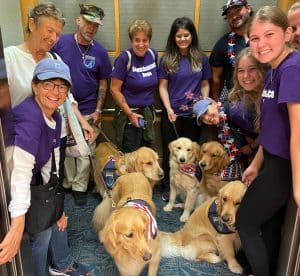Dog Training for Service: What You Need to Know
When people hear the phrase dog training for service, they often think of dogs in vests walking calmly beside their handler. But what makes a service dog different from pets, therapy dogs, or emotional support animals? The answer lies in extensive training and the ability to perform specific tasks that directly support a person’s disability.
In this article, we’ll cover how service dog training works, what to expect in the process, and how to make an informed decision if you or someone you know may require a trained service dog.
What Is Dog Training for Service?
 Dog training for service is a structured program designed to teach dogs how to help people with disabilities live more independent, fulfilling daily lives. Unlike emotional support animals, which provide comfort through their dog’s mere presence, a service animal must be individually trained to perform specific tasks for their handler.
Dog training for service is a structured program designed to teach dogs how to help people with disabilities live more independent, fulfilling daily lives. Unlike emotional support animals, which provide comfort through their dog’s mere presence, a service animal must be individually trained to perform specific tasks for their handler.
Examples include:
- Helping with mobility assistance (pulling wheelchairs, retrieving objects, or opening doors).
- Supporting people during an anxiety attack or post-traumatic stress episode.
- Guiding visually impaired people (commonly with guide dogs).
- Reminding someone to take their medication or alerting them to medical events.
Under the ADA and the Air Carrier Access Act, service animals—including dogs and in some cases miniature horses—are allowed in public places, commercial facilities, local governments buildings, and even on air travel with their handlers.
How Service Dog Training Works
Service dog training is more than just basic obedience training. It’s a step-by-step process involving both the puppy and the handler to ensure they can work as a reliable team.
- Foundation Skills – Puppies begin learning socialization, house manners, and how to behave in public spaces.
- Basic Obedience – Dogs learn to follow commands, stay calm in distracting environments, and maintain control in public access situations.
- Task Training – Each service dog candidate is taught specific actions to help with a person’s disability, such as retrieve objects, give mobility assistance, or provide alerts.
- Handler Training – The owners or handlers must also learn how to manage the dog effectively in everyday life. This ensures that the service dog and handler function as a unified team.
Training often takes 18–24 months, requiring dedication, consistency, and professional guidance from a professional service dog trainer or accredited organization.
Breeds Commonly Used in Service Dog Training
While almost any dog can potentially be trained, certain breeds are considered the best service dogs due to their temperament, intelligence, and adaptability. These include:
- Labrador Retrievers – Known for their eagerness to assist and strong work ethic.
- Golden Retrievers – Gentle, patient, and excellent for both children and adults.
- Standard Poodles – Highly intelligent and allergy-friendly.
The breed you choose should match the specific job or task required by the person’s disability.
Costs and Considerations
Dog training for service can be costly due to the amount of extensive training, time, and resources required. Costs vary depending on whether you train your own dog, adopt through an organization, or work with a professional service dog trainer.
Factors affecting cost include:
- Breed and puppy acquisition.
- Length and complexity of training.
- Handler training and follow-up services.
- Ongoing support and certification processes.
While the price can seem high, it’s important to remember that a highly trained service dog is not just an animal—they are a life-changing partner that can help a person regain independence.
Service Dogs in Daily Lives
For disabled individuals, service dogs provide more than just practical support. They assist with major life activities, bring emotional confidence, and perform work that enables freedom.
Whether it’s navigating public places, helping with mobility assistance, or even providing comfort in nursing homes, these working dogs transform the lives of many individuals every day.
About Genesis Assistance Dogs, Inc.
 At Genesis Assistance Dogs, Inc., we understand the power of a highly trained service dog in creating independence.
At Genesis Assistance Dogs, Inc., we understand the power of a highly trained service dog in creating independence.
Our mission: To provide ability and independence to transform the lives of people with disabilities, through the training and placement of highly skilled assistance dogs in Florida for children and adults.
Our vision: For people with disabilities to realize their full potential through the dedication, service and companionship of a highly skilled assistance dog.
📞 Contact us: (561) 329-0277
📧 Email: info@genesisassistancedogsinc.org
Frequently Asked Questions (FAQ)
1. What’s the difference between a service dog and an emotional support animal?
A service dog is individually trained to perform tasks for a person with disabilities, while an emotional support animal provides comfort through presence but is not considered a service animal required under the ADA.
2. How long does service dog training take?
Most dogs require 18–24 months of extensive training before becoming a certified service dog.
3. Can I train my own dog for service?
Yes, some people use their own dog, but success depends on the dog’s behavior, temperament, and ability to learn specific tasks. Working with a professional is strongly recommended.
4. Do service dogs have to wear vests?
No, the ADA does not require service dogs to wear vests, but many handlers use them to avoid confusion in public spaces.
5. Are service dogs allowed everywhere?
Yes. Under federal law, service dogs are permitted in public places, commercial facilities, and even on air travel, provided they are individually trained to assist with a person’s disability.
👉 If you’d like to learn more about dog training for service or are interested in how a highly trained service dog can transform lives, reach out to Genesis Assistance Dogs, Inc. today.

